Your Guide to Snorkeling Captain Cook Monument Hawaii
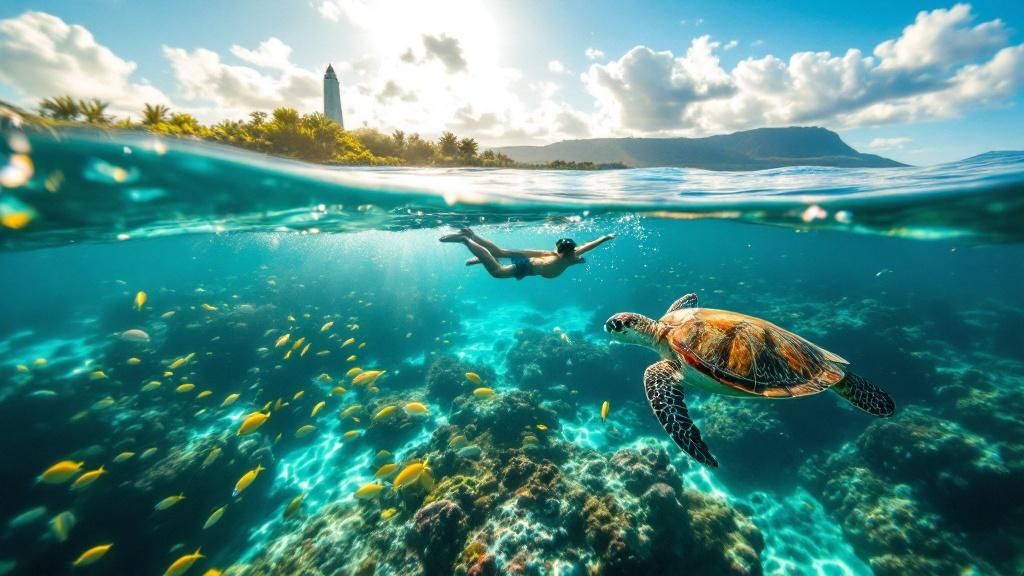
If you're looking for an unforgettable snorkeling experience on the Big Island, you’ve come to the right place. Captain Cook Monument isn't just another pretty spot; it's a world-class destination, and I'm here to give you the inside scoop. It's famous for its crystal-clear water, vibrant coral gardens, and deep historical roots that you can feel the moment you arrive.
Your Essential Guide to an Epic Snorkel Adventure
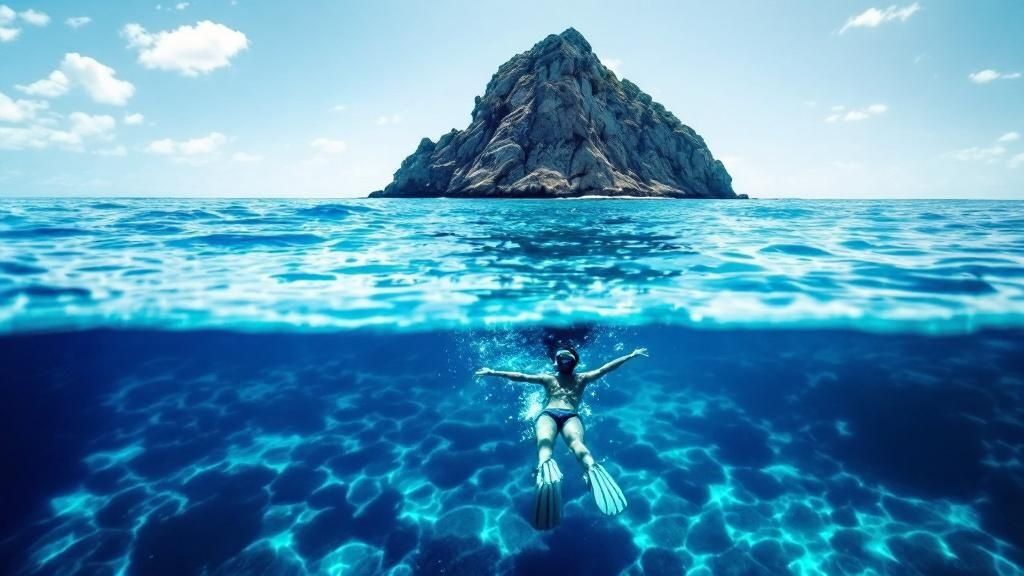
Think of snorkeling at the Captain Cook Monument as stepping into a massive, natural aquarium. Tucked away in the calm, protected waters of Kealakekua Bay, this spot boasts some of the best underwater visibility you'll find anywhere on the Big Island. But here's the catch: getting there is part of the adventure. You can't just drive up and park.
Honestly, this unique accessibility is what keeps it so pristine. The bay is a designated Marine Life Conservation District, a special status that shields its delicate ecosystem from being loved to death. This protection is why the coral reefs stay so healthy and the fish are so plentiful, offering an experience that's tough to beat.
Why This Spot Is So Special
The combination of Kealakekua Bay's remoteness and its protected status makes it a true sanctuary for marine life. Unlike crowded beaches where the underwater world can feel a bit worn out, the scene here feels wild and untouched. We'll walk through what makes this trip so unique and set you up for an adventure you'll be talking about for years.
It’s no secret that Kealakekua Bay is one of Hawaii's top snorkeling destinations, drawing over 190,000 visitors a year. Its fame isn't just tied to its history; it’s the incredible underwater clarity and biodiversity that really make it shine. You can dive deeper into what makes it a premier spot in this guide on the best snorkeling at Captain Cook Monument.
The bay's status as a Marine Life Conservation District is the real secret sauce. By limiting access and certain activities, the area stays healthier and more vibrant than many other easily accessible snorkel spots. It’s a perfect example of conservation working as intended.
How to Get There
Since you can't drive directly to the monument, figuring out how you'll get there is your first big decision. There are a few main ways to reach this snorkeling paradise, each offering a totally different kind of experience.
Here’s a quick rundown of your options to help you decide which adventure is right for you.
How to Reach Captain Cook Monument At a Glance
| Access Method | Difficulty Level | Ideal For | Key Consideration |
|---|---|---|---|
| Licensed Boat Tour | Easy | Everyone, especially families | Most comfortable and hassle-free |
| Permitted Kayak | Moderate | Adventurous paddlers | Requires a permit and physical effort |
| Strenuous Hike | Hard | Experienced hikers only | A very challenging 2.5-mile trail |
Each path has its own rewards. A boat tour is by far the easiest and most popular choice, giving you a comfortable ride with all your gear included. For a closer look at what these trips entail and the incredible local marine life, you can explore more about Captain Cook snorkeling tours to see if it's the right fit for your group.
Choosing Your Path to Kealakekua Bay
Getting to the incredible snorkeling at the Captain Cook Monument is the first real part of your adventure. You can’t just drive up and park, which is what keeps this spot so pristine. You've got three main ways to get there, and each one offers a totally different kind of day.
Your choice really comes down to your fitness, your budget, and what kind of story you want to tell later. Let's break them down so you can pick the right path for you.
The most popular and easiest way to get there is by boat. For anyone who puts comfort and convenience first, this is a no-brainer. Licensed boat tours whisk you right to the monument, taking care of all the planning for you.
The Ease and Comfort of a Boat Tour
Think of a boat tour as the express lane to paradise. These trips, which usually leave from Keauhou Bay, are perfect for families, first-timers, or really anyone who just wants a stress-free day on the water. You just show up, and the crew handles everything—the gear, the safety briefing, and getting you there and back.
When it comes to boats, you generally have two flavors to choose from for snorkeling Captain Cook Monument:
- Large Catamarans: These are like floating resorts. They’ve got tons of space, shade, bathrooms, and often include snacks or even a full lunch. They’re super stable and comfortable, which makes them a fantastic choice for all ages.
- Zodiacs and Small Boats: If you're looking for a more thrilling, intimate ride, a nimble Zodiac-style boat will get you there in a flash. These smaller boats give you a much closer-to-the-water feel, zipping across the bay with a smaller group of people.
No matter which boat you pick, you'll arrive at the monument fresh and ready to jump right in.
The Self-Powered Kayak Adventure
If you're craving a more hands-on journey and a decent workout, kayaking across Kealakekua Bay is a fantastic choice. This puts you completely in control. You can paddle at your own pace and soak in the dramatic coastline from a unique, water-level view.
But kayaking here isn't as simple as just grabbing a boat and going.
You must rent from a state-permitted vendor to get a landing permit. You absolutely cannot land a private or non-permitted kayak near the monument. This rule is in place to protect this very special and sensitive conservation area from being overrun.
The paddle itself is about a mile each way. It can get pretty challenging if the wind kicks up, which it often does. It’s a rewarding physical accomplishment, but you need to be honest with yourself about your group's fitness before committing.
While the monument is the main event, paddling gives you a chance to explore. You can find even more amazing underwater spots by checking out our guide to the top 15 best snorkeling spots on the Big Island.
The infographic below really puts the boat vs. kayak decision into perspective, laying out the differences in time, cost, and effort.
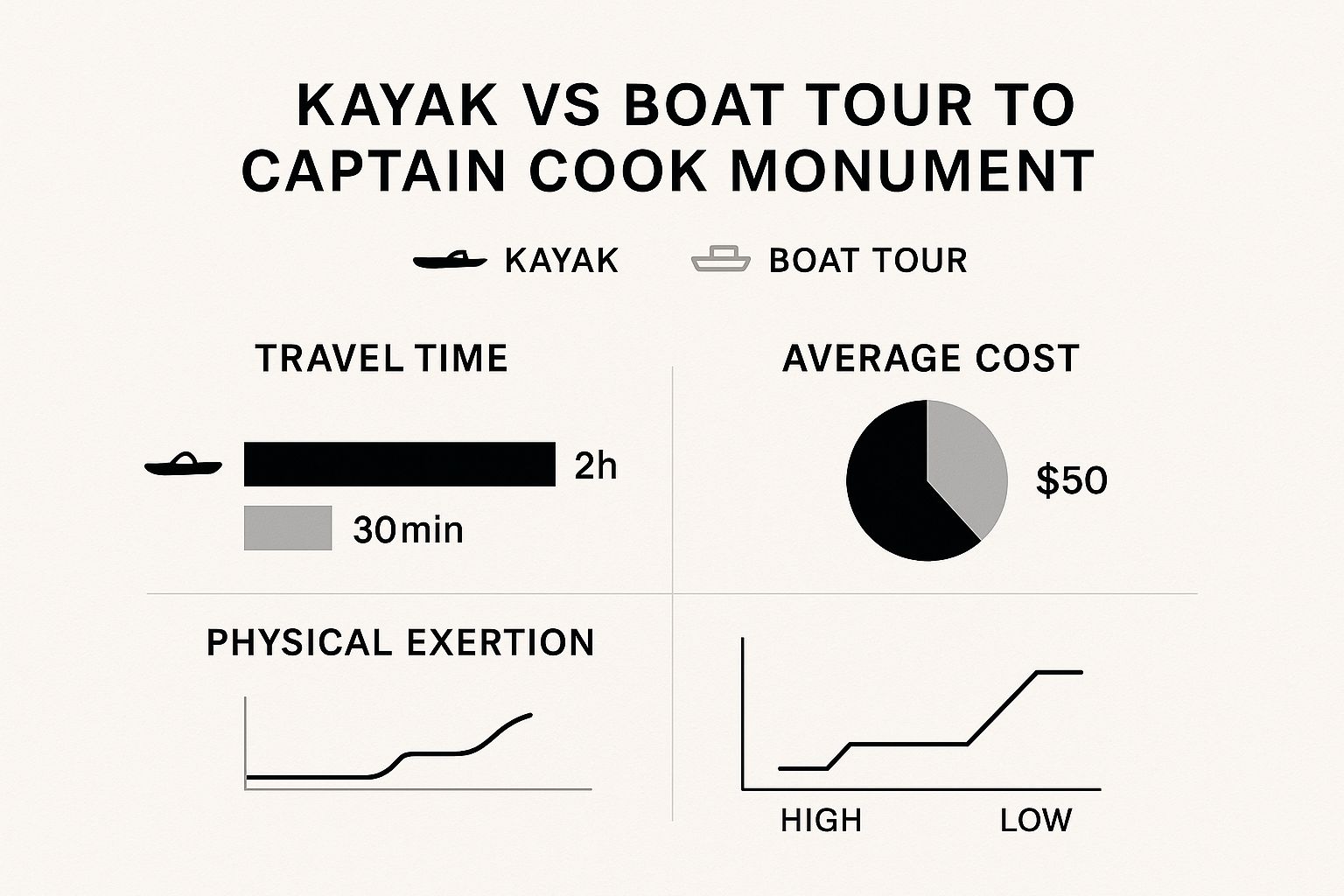
It’s a clear trade-off: a boat tour is fast and easy but costs more, while kayaking is cheaper but demands a lot more time and sweat.
The Challenging Ka'awaloa Trail Hike
For the truly ambitious and physically prepared, there's the Ka'awaloa Trail. This is, by far, the most demanding way to reach the monument. The trail is a steep, 3.8-mile round-trip hike that drops over 1,200 feet down to the bay.
The trek down is rocky, unshaded, and tough on the knees. But the real challenge is the brutal climb back up, especially under the intense Kona sun. This option is only for experienced, very fit hikers.
If you attempt it, you absolutely must pack in everything you need: tons of water (at least a gallon per person), sturdy hiking shoes, and all your own snorkel gear. It's a rugged, beautiful, and utterly exhausting journey.
Discovering the Best Time for Your Snorkel Trip
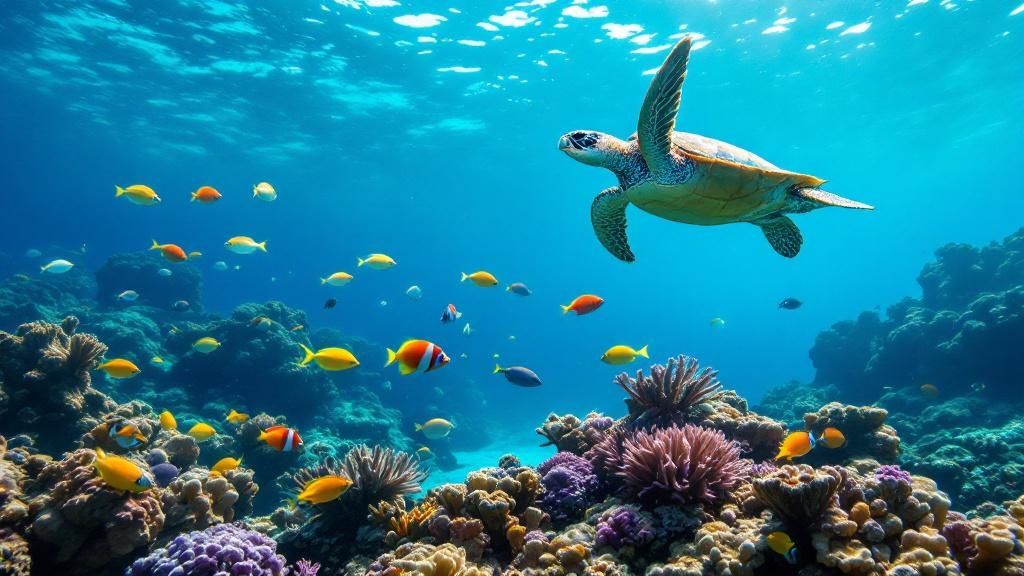
When you're planning your snorkeling Captain Cook Monument Hawaii adventure, timing is everything. It's the secret ingredient that turns a great trip into an unforgettable one. While the Kona coast has fantastic snorkeling year-round, knowing the local rhythms can make all the difference. We're talking the difference between choppy, crowded water and a serene, glass-like bay teeming with life.
Ask any local guide or seasoned snorkeler on the island, and they'll all tell you the same thing: go early. The morning hours, usually from about 8:00 AM to 11:00 AM, are the absolute golden window for Kealakekua Bay.
Why so early? Two huge reasons. First, you get the absolute best underwater visibility. The sun is at a perfect angle to light up the reef without creating a blinding glare, and the afternoon winds haven't had a chance to stir everything up yet. Second, you beat the crowds, giving you a much more peaceful and personal experience with the bay's incredible marine world.
Seasonal Sweet Spots
You can snorkel here any month and have a good time, but the "shoulder seasons" hit that perfect sweet spot of amazing weather and fewer people. If you can swing it, these are the absolute best times to explore Kealakekua Bay.
- Spring (April – May): The winter crowds have gone home, leaving behind calm seas and stunningly clear water. It’s a fantastic time to visit before the summer rush kicks in.
- Fall (September – October): Just like spring, the fall months bring wonderfully placid conditions. The ocean is still warm from the summer sun, and you'll be sharing the bay with far fewer snorkelers.
The real magic of an early trip is the tranquility. Imagine being one of the first people in the water, watching the reef wake up as sunlight streams down through the surface. It’s an experience that the tour groups arriving at noon will completely miss.
Understanding Local Weather Patterns
The Kona coast has its own unique microclimate. The mornings are almost always clear and calm, but the winds have a habit of picking up in the afternoon. This churns up the water, making it choppy, reducing visibility, and making a boat ride or kayak paddle a lot less comfortable.
Before you go, it's always a smart move to check a reliable local weather forecast for wind speed, especially if you plan to kayak. By scheduling your snorkeling Captain Cook Monument Hawaii trip for the morning, you sidestep those afternoon winds and guarantee yourself the best possible underwater views. For a deeper dive into timing your visit perfectly, you can explore our complete guide to the best time to snorkel on the Big Island. Planning around these simple patterns is the key to an unforgettable day.
Exploring the Vibrant Underwater World
Dipping your face below the surface at Kealakekua Bay is like stepping into a whole different reality. The water isn't just clear; it's a bustling, vibrant underwater city, and the locals are always ready to put on a show. The snorkeling at Captain Cook Monument is truly defined by the mind-boggling density and variety of sea life you’ll come face-to-face with.
This is worlds away from your typical beach snorkel. Because the entire bay is a protected Marine Life Conservation District, the ecosystem is incredibly healthy and thriving. The coral reefs are complex and colorful, creating the perfect apartments and buffets for a dazzling array of fish and other sea creatures.
The moment you put your mask in the water, you're hit with a kaleidoscope of movement and color. Brilliant schools of fish drift past like living clouds, creating a dynamic spectacle that's never the same twice. This is your chance to meet the residents of Kealakekua Bay, and they aren't shy.
Meet the Reef Residents
One of the first fish you're almost guaranteed to spot is the Yellow Tang. These bright, sunny fish often travel in massive schools, which looks absolutely stunning against the deep blue water. They are a true icon of Hawaiian reefs and pretty much impossible to miss.
Another common character is the Raccoon Butterflyfish. You can't miss its distinctive black "mask" around the eyes as it gracefully flits between coral heads. You'll also see plenty of Parrotfish, whose powerful beaks you can sometimes hear munching on coral—a critical part of keeping the reef healthy.
But the real treat for many snorkelers is spotting a fish found nowhere else on earth.
Keep your eyes peeled for Hawaii's state fish, the Humuhumunukunukuāpuaʻa (Reef Triggerfish). Seeing this unique and famously named fish in its natural habitat is a special moment for anyone snorkeling at the Captain Cook Monument.
Gentle Giants and Playful Pods
Beyond the endless schools of colorful reef fish, Kealakekua Bay is home to some larger, more majestic animals. It's not at all uncommon to see a Hawaiian Green Sea Turtle, or honu, gliding effortlessly through the water. These gentle giants are often seen grazing on algae near the reef, and watching them is a truly humbling experience. Just remember to give them plenty of space.
While a bit less predictable, pods of Spinner Dolphins are frequent visitors to the bay, often in the early morning or late afternoon. Their playful, acrobatic displays are a breathtaking bonus to any snorkel trip. Seeing them leap and spin out of the water is a memory that will stick with you for a lifetime. For a deeper dive into the marine life here, check out our full guide to Captain Cook Monument snorkeling.
The foundation for all this amazing life is the coral itself. The reefs here are incredibly intricate, forming complex underwater structures that provide shelter for countless species. From the tiniest shrimp to the largest turtle, every creature plays a part in this vibrant ecosystem. This delicate balance is exactly why responsible snorkeling—like not touching the coral—is so important. Your adventure is a front-row seat to one of Hawaii's most precious natural treasures.
Snorkeling Through A Story of Hawaiian History
When you slip your mask into the brilliant turquoise water of Kealakekua Bay, you’re doing more than just entering an underwater paradise. You're swimming straight into the pages of a living history book. Every gentle wave carries stories of ancient chiefs, fateful encounters, and pivotal moments that forever changed the Hawaiian Islands. Knowing just a little bit of this past transforms your snorkeling at Captain Cook Monument from a fun activity into a genuinely profound experience.
The bay’s modern story is, of course, forever tied to the British explorer Captain James Cook. He sailed into this very bay in 1779, marking the beginning of a massive cultural shift between Native Hawaiians and the Western world. What started as a celebrated arrival unfortunately ended in conflict and Cook's death right here. The iconic, 27-foot white obelisk you see on the shore is a stark memorial to that event, a permanent marker of a complex and transformative moment in Hawaiian history.
Beyond the Monument
While the monument is the first thing you’ll probably notice, the historical weight of Kealakekua Bay goes so much deeper and started centuries before Cook ever arrived. This place was incredibly important to Native Hawaiians. Directly across the bay from the monument, you can see the Hikiau Heiau, a sacred temple dedicated to the Hawaiian god Lono.
This temple was a major religious center, and the bay itself—whose name translates to "the pathway of the god"—was considered a sacred and powerful place. It’s a landscape absolutely soaked in mana (spiritual energy) and ancient heritage.
Thinking about the bay as a sacred space completely changes how you experience it. You’re not just a visitor; you're a guest in a place of immense cultural importance. Every kick of your fins is a gentle step through a site that holds deep meaning for the Hawaiian people.
Connecting with the Past
This rich history adds a powerful layer to your snorkeling adventure. As you watch a brilliant yellow tang dart through the coral, you can almost picture the grand canoes that once filled this bay. When you see spinner dolphins leaping in the distance, you’re witnessing a sight that Hawaiian chiefs saw centuries ago.
This connection to the past is what makes snorkeling at the Captain Cook monument in Hawaii so unique. It’s a chance to appreciate not just the stunning natural beauty but also the deep cultural and historical currents that flow through these waters.
For those wanting to dive even deeper, our guide on Big Island Captain Cook snorkeling provides more detail on how to fully appreciate your visit. This dual identity—as both a vibrant marine sanctuary and a historic landmark—is what truly makes Kealakekua Bay unforgettable.
Essential Tips for a Safe and Responsible Visit
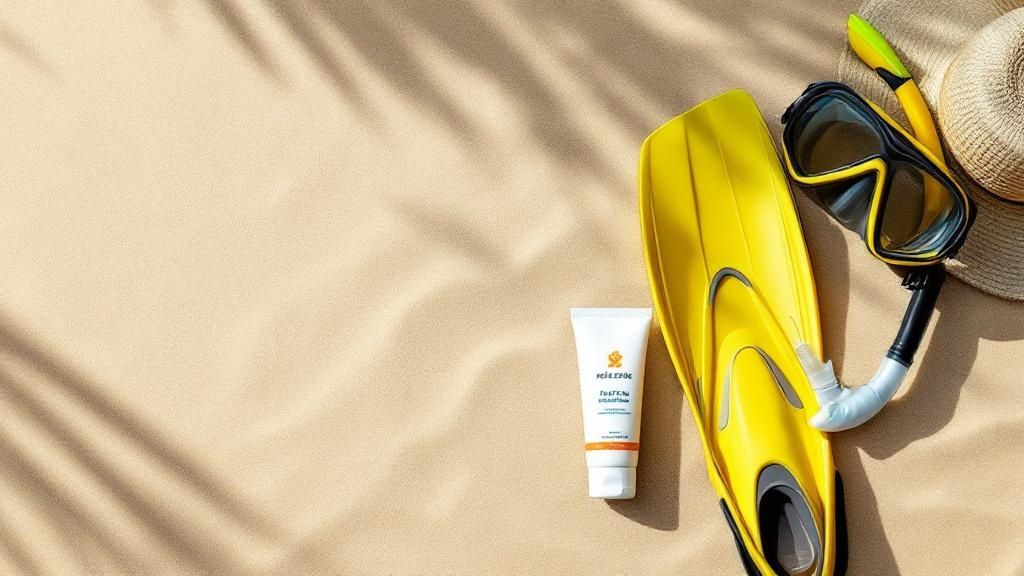
Any truly incredible trip while snorkeling Captain Cook Monument Hawaii boils down to two key things: keeping yourself safe, and protecting the very ecosystem you came all this way to see. It’s all about embracing the spirit of mālama kai (caring for the sea) to ensure this natural wonder stays just as magical for the next generation. This isn't just about a list of rules; it's about becoming a guardian of the bay.
Your most important contribution actually starts before your toes even touch the water. Hawaii state law is clear: you must use reef-safe sunscreen. Chemicals like oxybenzone and octinoxate are strictly banned because they literally bleach and kill coral. Always, always check your labels and opt for a mineral-based sunscreen that uses non-nano zinc oxide or titanium dioxide.
It’s a simple choice, but one that has a massive, direct impact on the health of the reef and all its vibrant residents.
Respecting the Marine Environment
The golden rule of snorkeling is simple, but it’s absolute: look, but don't ever touch. This goes for everything, from the intricate coral gardens to the graceful sea turtles (honu) and the colorful fish darting all around you.
Even a light touch can damage the delicate living tissue on coral, making it vulnerable to disease and death. Similarly, getting too close to or touching marine animals causes them a huge amount of stress. It can disrupt their natural patterns of feeding, cleaning, and resting. Just hang back and observe all wildlife from a respectful distance.
Remember, you're a guest in their home. The absolute best way to show your respect is to be a quiet, passive observer. Just let the underwater world unfold around you without interfering. Your calm presence is what helps preserve the magic of Kealakekua Bay.
Personal Safety and Preparedness
Out on the water, conditions can change in a flash, even inside a protected bay like Kealakekua. Always snorkel with a buddy and stay aware of your surroundings, especially any boat traffic. Before you hop in, take a minute to look at the water, feel the currents, and plan your swim so you can drift with the flow, not fight against it.
Packing smart is also a huge part of having a safe and fun day, particularly if you're making the trek by hiking or kayaking.
- Hydration is Key: That Kona sun is no joke. Bring way more water than you think you'll need. If you're doing the hike, double it.
- Pack Your Provisions: There are no snack shacks or stores down at the monument. You need to pack in all the food and snacks you’ll need to keep your energy up.
- First-Aid Basics: A small, waterproof first-aid kit for the inevitable scrape or cut is always a smart thing to have in your pack.
Follow these tips, and you’re all set for an adventure that’s not just amazing for you, but responsible and safe for everyone.
Your Top Questions Answered
When you're planning an adventure like snorkeling Captain Cook Monument Hawaii, a few questions always pop up. It's totally normal. We get these all the time, so we've put together some straight-up answers to help you get your plans sorted and feel confident for an amazing day out on the water.
Can I Drive Directly to the Monument?
Nope, you can't. There’s simply no road that goes down to the monument. The state intentionally keeps this part of Kealakekua Bay remote and inaccessible by car to protect its stunning, untouched environment. The only ways to get there are by joining a licensed boat tour, paddling over in a permitted rental kayak, or tackling a seriously tough hike.
Do I Need a Permit to Snorkel at Captain Cook?
This really boils down to how you decide to get there. If you book a spot with a legitimate boat tour company, you're all set. The tour operator handles all the required permits and landing rights for you—no extra work on your part.
Now, if you're thinking about kayaking, you must rent from a vendor that's been permitted by the state. These are the only companies that can issue the landing permits you'll need for the area around the monument. Showing up with your own private kayak or a non-permitted rental means you won't be able to legally land.
The permit system is absolutely essential. It helps manage the flow of visitors and protects the bay's incredibly fragile ecosystem, ensuring that this special place stays pristine for years to come.
What Is the Best Sunscreen to Use?
You have to use a reef-safe sunscreen. It’s not just a suggestion; it's the law in Hawaii. The state has banned sunscreens containing the chemicals oxybenzone and octinoxate because they've been proven to bleach and kill our precious coral reefs.
Always look for a mineral-based sunscreen. The good ones will list non-nano zinc oxide or titanium dioxide as their active ingredients.
For more answers to common questions, you might find our general guide helpful. It covers frequently asked questions about Kona snorkel tours.
Ready for an underwater adventure you’ll never forget? Let Kona Snorkel Trips handle all the details. Book your Captain Cook snorkel tour today and get ready to explore one of Hawaii's most spectacular marine sanctuaries.
